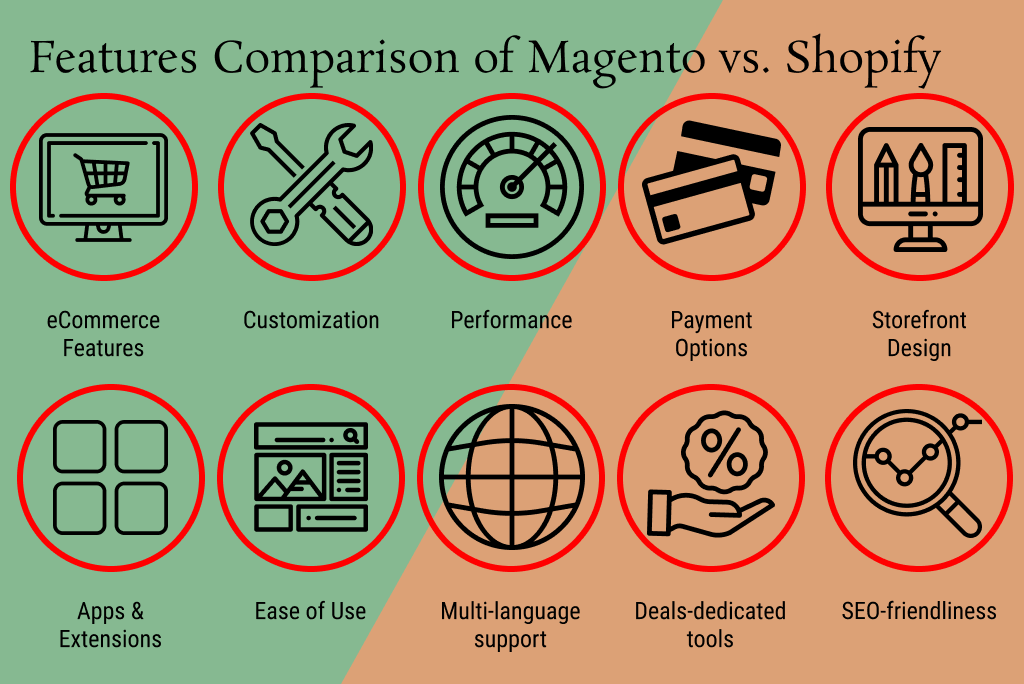The selection of an eCommerce platform that aligns with business necessities defines the future success or failure of a project.
When we look at the market of eCom solutions, Magento 2 and Shopify are clearly the leading names there.
They often become a primary choice to create a store within a set budget and timeframe.
The possibility of marking the right choice depends on a comprehensive understanding of the weaknesses and strengths that the solutions possess. You should decide upon a system before starting the development process as moving all eCommerce operations to a new system later will cost you time and money.
The article covers the main aspects of both and provides the following information:
- Magento and Shopify comparison
- how the counterparts are similar and different
- use-associated costs
Magento vs. Shopify: Reasons for Choosing One of Them
Why should you make a choice between Shopify and Magento, and not another eCommerce site-building solution?
The answer to the question lies in numbers. The main statistics prove that these two are worthy of sellers’ attention. While they both allow creating eCommerce stores, they differ in many aspects.
- Shopify
Let’s start with this platform. According to data provided by it, its solution powers 820,000+ online stores worldwide. As for Shopify Plus, which is an enterprise solution, 5300+ businesses are utilizing this version of Shopify.
According to recent statistics, Shopify holds the third position among eCommerce platforms with a market share of 10.03 percent. From June 2018 to June 2019, the platform had 218 million buyers and helped merchants to generate $41.1 billion in sales. If a person has made a purchase online, it is a high chance it was made on a website built with Shopify.
- Magento
Magento also stays ahead of the game. It is now a leading eCommerce platform in the world for more than 2 years in a row. All versions of the platform comprised take up to 12% of the market share of the world scene.
In 2019, 260,000+ websites are operating on Magento. The platform is particularly popular among the top 1000 retailers in North America. Magento is used by such retail leaders like Walmart and Adidas.
Big brands love Magento. Over 6.2 percent of Magento sites are featured among the top 1m sites worldwide as compared to 2.51 percent of Shopify stores. If you look at the top 1k websites, 0.07 percent of Magento stores are within this group, and only 0.05 percent of Shopify stores.
As you can clearly see, Magento and Shopify are two popular solutions that are used to develop and manage eCom stores. The latter platform is especially popular among big retailers who need a reliable store with high performance.
Magento vs. Shopify: Main Features and Strengths
Commons and differences between Shopify and Magento are plenty and diverse. Without a deep understanding of them, you will not be able to decide on the solution that will keep up with business tasks, and that is easily configured to your requirements.
- eCom features
There are a lot of features provided by both platforms since they were created specifically for the eCommerce industry. Regardless of your choice, you will get a set of primary features, including the ones for the implementation of shopping carts, checkouts processes, product pages, and much more.
The differences become more prominent when we look at more advanced and complex tools and built-in functionality. In this domain, Magento is a winner. Some specific features can be even added with additional extensions. The same goes for Shopify and its dedicated apps, the use of which increases the initial prices that are required for a basic store creation.
- Customization
eCom business owners are often worried about customization options as they want to create a unique user experience for customers. In this regard, the differences between Shopify and Magento become more prominent.
Hosting is where the main distinctions between the two are hidden. Shopify belongs to the hosted solutions, while the situation with Magento is a little bit more complicated due to the availability of a few editions.
What does hosted mean for business? Clients of Shopify do not have to deal with setting up a server or finding a hosting provider. However, the coin has two faces. While technical knowledge is not required, Shopify has limited functionality, which results in low-level customization. It means you save money on hosting while sacrificing the ability to add an extra feature or two that might become a deciding factor for your customers.
Magento has three types of editions. The free and Magento Commerce versions require users to deal with hosting providers or setting up their own servers at additional cost. At the same time, it leaves a lot of space for accommodation and the addition of extra and even unique features.
Magento Commerce Cloud is distributed as a hosted solution, but with it comes tremendous expenses.
- Performance
The difference in hosting options leads to another issue – performance.
The load time predetermines whether a store converts visitors into customers, as the hectic modern life does not allow users to wait long for a website to load. With Shopify, you entirely rely on the resources it can provide its sellers with.
With Magento open-source, it is possible to rely on the best servers and optimize them to meet the ever-growing business resources. What is more, Magento offers enough productivity for a multi-store environment and can even smoothly run with thousands of different product listings.
You should pay close attention to this aspect when choosing Shopify versus Magento.
- Payment options
There is a direct correlation between the provided payment options and the cart abandonment rate, as it is one of the main reasons why shoppers do not precede the purchase.
Both platforms have a lot to offer. Shopify provides support for over 70 payment systems. At the same time, it sellers sometimes feel stressed to use its main payment gateway that has zero transaction fees. Otherwise, they are required to pay an additional fee.
While Magento has fewer built-in options, you can add many payment options with third-party APIs. Magento supports 148 payment processors worldwide – enough not to feel limited in choice.
- Storefront design
Themes and templates are the most time and cost-efficient way of getting the design of a store created. Both platforms offer a lot of options; however, Magento Open-Source has a bigger number of them.
It also needs to be mentioned that Shopify leaves little to no space for customization. All you can do is to adjust the overall appearance by changing fonts and colors. Magento, on the other hand, allows for a higher level of the store layout and design customization by changing the source code.
- Apps and Extensions
After a store is set and alive, sellers often find themselves in need of some unique functionality. Shopify and Magento allow broadening the functionality, like adding one-page checkout or advanced navigation.
In this domain, Magento is the winner, with 5000+ extensions available. You can find both free and paid options. It has a broad and strong community that works hard and releases a lot of useful extensions that bring in so much needed functionality.
Shopify lags far behind its competitor, with only 100+ apps available. The platform has quite a high bar for its apps.
- User-centric
That is the main point where Magento loses to its competitor. The latter is like a traditional website builder that is designed to be user-friendly. Depending on your skills, it can take up a few hours to get your store up and running. However, the main sacrifice is made in regards to functionality.
Magento is an entirely different story, as there is nothing simple and easy about it. You will probably need to hire developers to get the job done. But its strong sides make the platform popular among big brands and business owners who do not leave chances to lost sales due to underperforming designs, standard templates, and limited functionality.
- Multi-language support
If you are contemplating the idea of launching your store in the international arena or just provide it in multiple languages, Shopify might not be the best choice. There are no such built-in capabilities. Multi-language support can be added by changing code in Shopify themes, which entails hiring a developer and paying for the job to be done, which contradicts the main idea behind the solution.
Multi-language is one of the core features of Magento. Even if you think you do not need it, such functionality may be needed in the future with the expansion of your eCom business.
- Deals-dedicated tools
Sales and discounts are an integral part of the eCommerce business, which allows for fast growth of revenue. That is why the importance of dedicated tools cannot be underestimated. It might be best to center business operations on the platform that offers such functionality as an integrated option. Shopify and Magento provide such features, but if all versions of Magento allows creating and discounts, users of the basic plan by Shopify do not have such privileges.
Inventory management is also more advanced in Magento. It caters to all sellers’ needs and allows creating product listings with different variations for size, color, etc.
- SEO-friendliness
All the efforts of setting up a store can end up in vain if the website is not ranking. Search engine optimization is a pressing matter for business owners of all sizes. What a use in a store if it is ranked #50th in search result?
In this regard, you do not have to worry about whether choosing Magento or Shopify. Both provide SEO-dedicated features. The difference between the features provided by Shopify and Magento is in their extensive capabilities.
Shopify provides a built-in solution to edit meta tags, make product pages more SEO-friendly, and to optimize the file structure to help crawlers with their job. At the same time, as the platform is hosted, it is not possible to make any changes on the server-level.
Magento, being non-hosted, goes even further. It is possible to add specific tools for marketing and SEO efforts with third-party APIs. With the platform, you can take full advantage of on-site SEO with the tools that are designed to make the structure of a website more understandable, thus simplifying the process of site crawling by search engines.
When you look at the above comparison between Magento and Shopify, there is no brainer why big brands choose the latter. Below is a table summarizing the features of the platforms, their unique aspects, and strong points.
| Features | Magento | Shopify |
|---|---|---|
| eCommerce functionality | Basic features and more advanced tools | Basic functionality |
| Customization | Highly customizable | Limited customization |
| Speed | Non-hosted Can be optimized to the highest performance |
Hosted, no control over the servers |
| Payment gateways | 148+ payment processors | 70+ payment systems |
| Design | Advanced customization of store layout and design | Basic design customization |
| Apps & Extensions | 5000+ extensions | 100+ apps |
| Built-in multi-language support | + | – |
| Sales tools (discounts, coupons, etc.) | + | + (not provided for Basic Shopify) |
| SEO | Advanced website and server SEO optimization | Basic SEO website optimization |
Magento vs Shopify: Expenses
Price is another deal-breaker when it comes to choosing an optimal business solution. In this regard, the two platforms differ tremendously.
- Magento
It makes sense to start with Magento and its three versions. The open-source solution is free-of-charge, but only if you possess technical knowledge and readiness take on coding. The prices for hosting start at $4 per month and can reach up to a few hundred depending on the needed capabilities and performance.
If you are not a technical professional, you will need to hire developers who will take on the task and develop a store for you. Depending on the technical specification of a future website, required functionality, performance, and other capabilities, the development prices start at $1.000 and up.
There are also two other types of Magento Editions – Enterprise and Enterprise Cloud, which differ in the hosting options. The second one is hosted so that you won’t need to worry about finding a reliable service provider. The prices of these two depend on the generated revenue and start at 22,000 for Commerce and $40,000 for Commerce Cloud.
Interested in building a Magento website and want to know what budget should you have?
Check out the article How Much Does a Magento Website Cost: Editions, Services, & Additional Expenses with the step-by-step process of estimating the possible costs that are related to development.
- Shopify Costs
Shopify is a paid solution with a set monthly payment. There are two main plans and two additional ones:
- Shopify Lite – designed for direct sales on Facebook for $9/month
- Basic Shopify – aimed at beginners in online retail and costs $29/month plus a 2% transaction fee
- Shopify – designed for pro sellers and costs $79/month with 1% transaction fee
- Advanced Shopify – offers advanced features for $299/month with 0.5% transaction fee
- Shopify Plus – created for high volume sellers and starts at $2,000/month
Why Magento is Better Than Shopify: Final Thoughts
Is Magento better than Shopify?
If you are looking for a strict yes or no answer, you are not going to get one. It depends on the angle from which you contemplate the matter. Both platforms are designed for eCommerce but with entirely different purposes.
Shopify is better suited for individual sellers who consider online retailing as a side hassle.
Magento, on the other hand, is designed for professional sellers who need high-performance online stores, individually designed storefronts, and customized features. That is why many big and small brands chose the Magento platforms to power their webstores.






